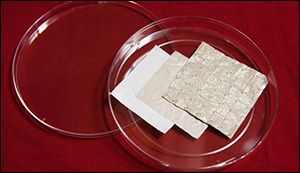Stanford engineers develop a plastic clothing material that cools the skin
2. 9. 2016 | Stanford University | news.stanford.edu
Stanford engineers have developed a low-cost, plastic-based textile that, if woven into clothing, could cool your body far more efficiently than is possible with the natural or synthetic fabrics in clothes we wear today.
This new material works by allowing the body to discharge heat in two ways that would make the wearer feel nearly 4 degrees Fahrenheit cooler than if they wore cotton clothing. The material cools by letting perspiration evaporate through the material, something ordinary fabrics already do. But the Stanford material provides a second, revolutionary cooling mechanism: allowing heat that the body emits as infrared radiation to pass through the plastic textile.

To develop their cooling textile, the Stanford researchers blended nanotechnology, photonics and chemistry to give polyethylene – the clear, clingy plastic we use as kitchen wrap – a number of characteristics desirable in clothing material: It allows thermal radiation, air and water vapor to pass right through, and it is opaque to visible light.
Read more at Stanford University
Image Credit: L.A. Cicero
-jk-




